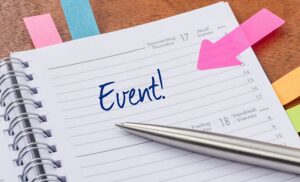When it comes to events, your desired results at the event’s end is your guiding star. Did your event land new clients? Build a mailing list of potential customers? Cement relationships with current customers? Increase visibility and executive thought leadership? Raise product sales? Capture attendee contact information?
None of this will happen unless you focus on the end first. Thorough and detailed planning, SNAFU anticipation, measurement and precise execution are crucial, but the outcomes are really all that count on the scorecard.
1. Plan the plan
How will you know you reached your goals and objectives when the event is over? You will achieve success if, from the first day of conceptualizing and planning the event, you create a mission statement and list goals that you will measure and recap at the event’s end.
“From day one, always be thinking about the end of an event,” says Teresa Sandros, Bliss Events owner.
Smart event planners meet early and often with their teams and vendors. Together, they mentally walk through the minutia of the event. No detail is too small to consider, from discussing what might go wrong, developing a backup plan, deciding how many chairs, how many ushers will be needed, and deciding to order extra power sources for guest laptops. Every planning meeting should be, ultimately, about the ending.
2. Automate your event
To maximize your outcomes and to be better satisfied with your event once it ends, turn to technology early in the game. Through well-chosen apps and platforms, you will be able to gather feedback and engage audiences prior to, during, and after the event. Data is especially helpful in the case of annual events.
Before the event, technology and social media can help you build excitement and increase registrations. During the event, keep energy high by designating staff to live tweet quips, photos and videos.
You can also synchronize your marketing platforms and event data with customer relationship management (CRM) tools. Applications such as ThriveHive can help manage online marketing and ensure that social advertising, search engine optimization (SEO) and search engine marketing (SEM) are on point. Use social media tools such as Hootsuite to aggregate publishing and schedule posts across platforms in advance. Trello, an inexpensive project management tool, can help the team keep track of tasks and communicate. Slack is also useful for team collaboration.
Use technology for as many functions as possible.
All of this leads to ensuring the sort of event ending you desire.
Polling during an event allows you to immediately course correct in case of a SNAFU such as AC turned too high, heat too low, missing coffee service or a broken sound system. Correcting a problem on the spot, and informing your audience that the problem or weakness has been resolved, decreases the likelihood that guests will turn to social media to complain.
If you do wait until after the event to survey, offer incentives such as gifts, discounts, free product trials and invitations to your next event to increase the response rate.
3. If anything can go wrong, it will
“Just because somethings seems logical and obvious to you doesn’t mean a client, venue vendor or guest will agree,” she says.
She adds, “Document everything! Written confirmation between you and vendors, your team and your company is essential.”
4. What to do if you mess up
Even with the best plan in place, something will go wrong. Immediately find out what went wrong and why.
“Own your part and apologize,” says Sandros. “Present specific ways you, your team and vendors will improve in the future.”
When mishaps occur, the audience and your team will be looking to you for leadership. Keep a positive attitude. Breathe deep. Maintain your sense of humor. Ensure that the audience still feels welcome. You want them to know by observing your composure and confidence that you will make things right.
Don’t beat yourself up or become emotional. Never draw unnecessary attention to the mistake. Attendees can be forgiving when they see that you, like them, are only human.
5. The event is over. Now what?
The event has finally drawn to a close, but you aren’t done yet. It’s time to evaluate all data. Did you reach your goals? How many units were sold and new customers gained? How many attendees make purchases in the months following the event? What did you learn from attendee feedback?
Most important of all, hold a debrief with all vendors and team members. What went well? What could improve? Keep your notes to inform next year’s event. Provide a written report to your employer with recommendations for the next event.
You can finally relax, but don’t get too comfortable; the next event is right around the corner.

